Bitcoin
Texas leaders worry that bitcoin mines threaten power grid
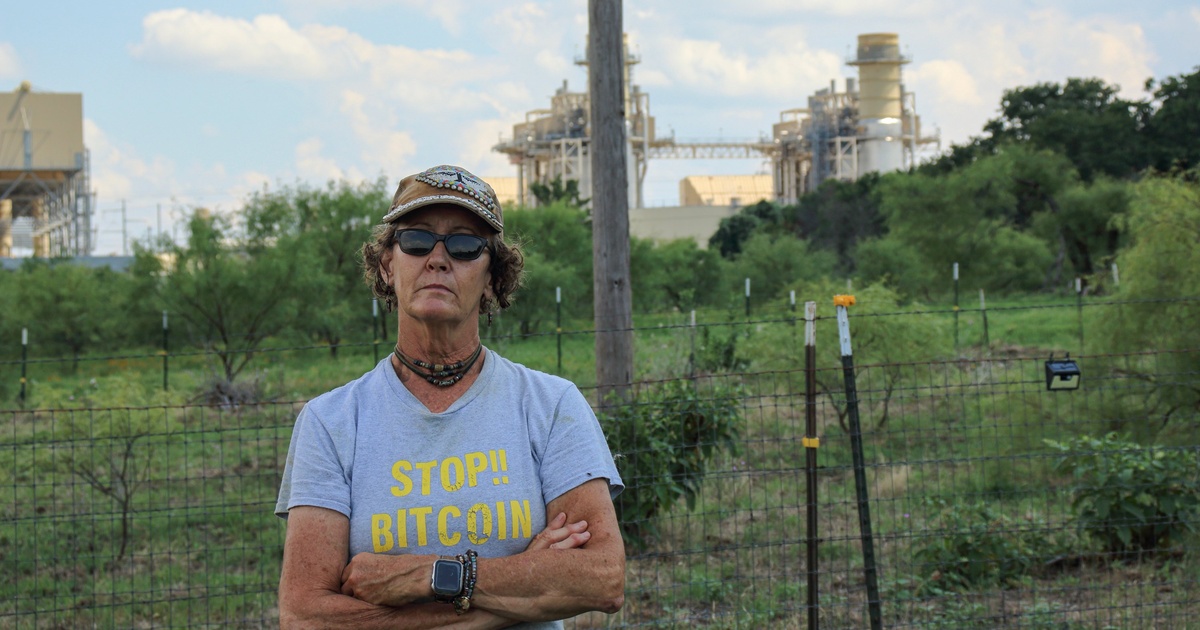
We’re testing using AI-powered tools to provide an audio version of this story. While this audio recording is machine-generated, the story was written by human journalists. Read more on our AI policy.
Sign up for The Brief, The Texas Tribune’s daily newsletter that keeps readers up to speed on the most essential Texas news.
This story is published in partnership with Inside Climate News, a nonprofit, independent news organization that covers climate, energy and the environment. Sign up for the ICN newsletter here.
GRANBURY — Cheryl Shadden cannot sleep. The 61-year-old nurse, who works at hospitals giving patients anesthesia, says she is kept up at night by the nonstop mechanical whir of fans spinning to cool tens of thousands of computers.
Shadden lives in Granbury, about 40 miles southwest of Fort Worth, with her seven dogs, six horses, six cats and a parrot. In 2022, after 23 years in the area, Shadden got a new neighbor: a 300-megawatt Bitcoin facility, referred to as a “mine,” where computers run around the clock to help maintain a global network of transactions in the cryptocurrency.
“Nobody in their right mind would live here,” Shadden said. “My windows rattle. The sound goes through my walls. My ears ring, 24/7.”
Since the facility opened, Shadden said her animals are restless, and some of her dogs have pulled out their own fur. In late June, Shadden went to a doctor to get her hearing examined, and tests found she had suffered permanent hearing loss. She believes her animals’ behavior and her hearing loss were caused by the noise from the Bitcoin mine.

Cheryl Shadden stands in her backyard with several of her Great Pyrenees dogs.
Credit:
Keaton Peters/Inside Climate News
Noise pollution is not the only reason that Bitcoin mining may be keeping Texans up at night. The mine owned and operated by Marathon Digital is part of a growing tide of cryptocurrency mining facilities opening across the country, but especially in Texas, where taxes are low, land is plentiful and mining companies can take advantage of the state’s deregulated energy market. As electricity demand rises, ordinary Texans can end up paying the price on their monthly utility bills.
Bitcoin is the largest and best known cryptocurrency, first devised in 2008 as an electronic payment system that cuts out middlemen like banks and credit card companies, with all transactions managed by a decentralized network of Bitcoin users. A Bitcoin, currently worth about $58,000, can be purchased with dollars at a Bitcoin exchange, like Coinbase. To buy something with Bitcoin, a buyer sends the currency from a digital wallet to the seller’s digital wallet.
But it’s not that simple. A computer algorithm assigns each transaction a unique random identifying code, which must be guessed in order to validate the transaction. Bitcoin “mining” comes when companies operate powerful computers day and night running endless series of random numbers before hitting upon, or guessing, the correct code. Every time a Bitcoin miner’s computer successfully guesses a transaction code, the miner receives 3.125 newly minted Bitcoins (worth about $181,250 at the current price), which is the fee for helping maintain the network and keep it secure.
The system is designed so that it takes an average of 10 minutes for a Bitcoin miner somewhere in the world to guess a code and verify a transaction. But as Bitcoin miners add computing power to verify more transactions, the system’s algorithm makes the process harder by generating longer codes, creating what has been called an energy arms race, requiring larger and larger amounts of electricity to run the computers.
Texas is now home to 10 of 34 large Bitcoin mines.
During cold spells or heat waves, Texans are commonly called on to conserve power. For example, in August 2023, the state’s grid operator issued eight conservation requests, asking the public to reduce electricity use to help prevent an emergency in which rolling blackouts could be required. Increasingly, Texas lawmakers are worried that energy-hungry mines will make it harder to keep the lights on across the state.
“They’re going to put our grid at risk because of the power they’re drawing,” said state Sen. José Menéndez, D-San Antonio, at a public hearing on June 12.
For more than six hours, senators on the Business and Commerce Committee pressed grid operators, public utility commissioners and representatives from industries, including manufacturing, oil and gas and cryptocurrency. Chief among legislators’ concerns was the massive growth in energy demand on the state’s main electrical grid, which is estimated to go from a peak demand of about 85,000 megawatts last year to 150,000 megawatts in 2030, according to estimates from the Electric Reliability Council of Texas.
Following the hearing, in a post on social media, Lt. Gov. Dan Patrick declared, “it can’t be the Wild Wild West of data centers and crypto miners crashing our grid and turning the lights off.”
Power plant loans
Currently, cryptocurrency mining — mostly for Bitcoin — can draw up to 2,600 megawatts of power from the grid operated by the Electric Reliability Council of Texas, ERCOT’s senior vice president, Woody Rickerson, told senators. That’s about the same amount of power used by the city of Austin, and another 2,600 megawatts of mining is already approved to connect to the grid. Even more Bitcoin mines are expected to come to Texas in the near future.
ERCOT estimates that as much as 43,600 megawatts of additional electricity demand will be added to the grid by 2027 from facilities classified as “Large Flexible Loads” requiring more than 75 megawatts. In a statement to Inside Climate News, ERCOT said, “currently, the crypto mining industry represents the largest share of large flexible loads seeking to interconnect to the ERCOT System.” Data centers for artificial intelligence and facilities for producing hydrogen from water through electrolysis also make up part of the large flexible loads.
To meet the major growth in demand, driven in large part by Bitcoin mining, Texas is turning to natural gas power plants, with taxpayers providing the down payment. In 2023, the Texas Legislature passed a loan program, later approved by voters as ballot Proposition 7, to give low-interest loans to companies to build or expand power plants. At first, the Texas Energy Fund will have $10 billion to award, after receiving more than $39 billion in requests.
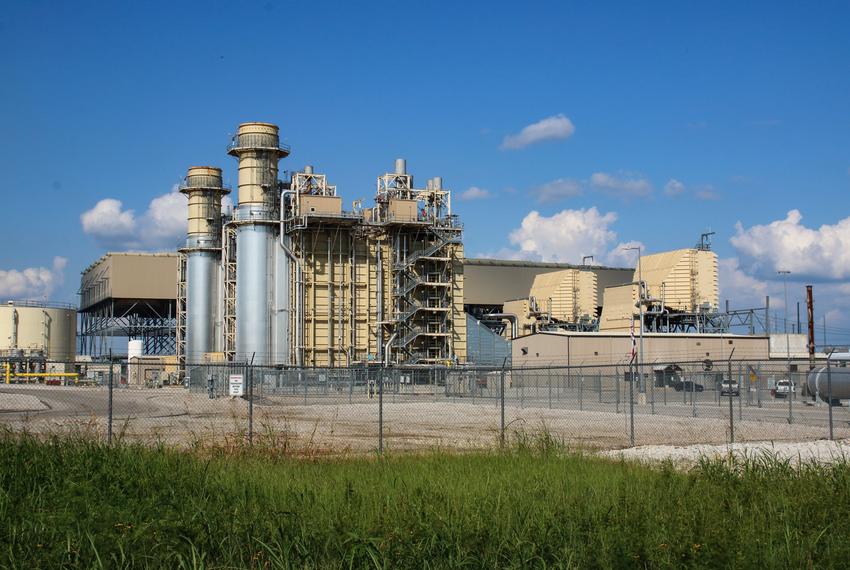

A view of the Wolf Hollow II power plant, owned by Constellation Energy, in Granbury.
Credit:
Keaton Peters/Inside Climate News
One of the companies applying for a loan is Constellation Energy, which owns the Wolf Hollow II power plant in Granbury. Constellation has an agreement with Marathon Digital, allowing Marathon to rent space next to the power plant for Bitcoin mining and purchase power directly from Wolf Hollow II.
Marathon has a capacity to use up to 300 megawatts of power, and Constellation wants to add additional turbines onto Wolf Hollow II capable of generating that much power.
In an application to the Texas Commission on Environmental Quality, Constellation said the power plant expansion would include eight turbines, and it applied for air permits to release more than 796,000 additional tons of carbon dioxide per year. Such massive greenhouse gas emissions have made cryptocurrency mining the focus of intense opposition by climate activists.
Bitcoin can “game the system”
The deal between Marathon and Constellation, known as a power purchase agreement, is part of what makes Bitcoin mines major players in the Texas energy market — not simply consumers of power. In most agreements, crypto facilities lock in a relatively low rate to purchase electricity “behind the meter,” so the supply does not enter the ERCOT market. But Bitcoin mining companies can later decide to sell that power to the rest of the grid through the ERCOT market, rather than powering their computers.
For example, Riot Platforms operates two of the largest existing Bitcoin facilities in the world, both located in Texas. The New York Times reported last year that Riot Platforms’ operation in Rockdale was the most power-intensive Bitcoin mining operation in the country, using “about the same amount of electricity as the nearest 300,000 homes.”
One of the facilities has been able to pay as low as 2.5 cents per kilowatt-hour of electricity, while the average price across Texas in 2022 was more than 10 cents.
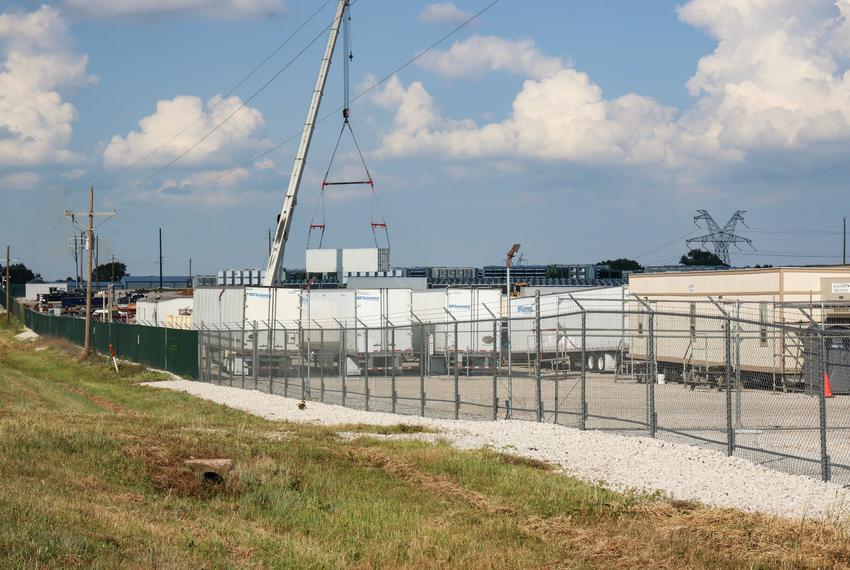

Trucks are parked alongside containers of computers owned by Marathon Digital at the Bitcoin mine in Granbury.
Credit:
Keaton Peters/Inside Climate News
In August 2023, when energy prices were high amid scorching summer days, Riot Platforms made $24.2 million from reselling power purchased through their private agreements onto the wholesale energy market, almost tripling the $8.6 million the company made that month mining and selling Bitcoin.
“They can game the system in a few different ways for their profit,” said Mandy DeRoche, an attorney at the nonprofit Earthjustice, who has worked on cases involving crypto mines across the country.
Separately, Bitcoin companies can participate in demand response programs, in which the companies allow ERCOT operators to control the energy load of the facility and lower their usage to compensate for sudden outages or periods of high demand elsewhere on the grid. These situations arise most often during extreme weather. Companies get paid a premium by ERCOT for participating in demand response, and they get paid an additional fee each time their energy load is controlled through the program. Riot Platforms made $7.2 million from these programs in August 2023, according to a monthly earnings report.
“Texas has set up a system which allows crypto mining to be significantly advantaged,” said state Sen. Charles Schwertner (R-Georgetown), the chairman of the Business and Commerce Committee.
Those millions in profit don’t appear out of thin air, and consumer advocates are worried the burden falls on Texans such as Cheryl Shadden and her neighbors in Granbury. “The cost is passed directly on to ratepayers,” said Adrian Shelly, Texas director for the nonprofit Public Citizen. Bitcoin miners “are ideally positioned to manipulate the energy market in a way that will drive up prices for consumers.”
With three distinct ways to profit — energy-intensive computations to “mine” Bitcoin, selling power on the wholesale energy market or participating in demand response — each decision will impact the availability of energy for most of Texas. And which method miners choose is highly variable.
As DeRoche explains, “if the price of Bitcoin is fairly low, then there’s more incentive to turn off [their computers] in peak demand or in extreme weather.”
This year, the price of Bitcoin has soared to record highs and remained steadily around $60,000 since March, about twice as high as in August 2023. With the price up, DeRoche said it will be harder to predict whether miners will power down when energy becomes scarce.
A phased plan for noise reduction
From the industry perspective, Bitcoin advocates say the flexibility of mining operations makes the grid stronger. “We need more price sensitive loads on the grid, not less,” said Lee Bratcher, president of the Texas Blockchain Council, in an email to Inside Climate News. “By locating in rural areas with too much power and not enough transmission capacity to get that power to major population centers,” Bratcher said the cryptocurrency mining industry is using power that would otherwise go to waste.
He added that many mines operate at full capacity during the night when demand is low and power down “during high power demand times like during hot afternoons in the summer or winter cold snaps.”
Bratcher, as well as representatives from Marathon Digital and Constellation Energy, declined to be interviewed. In an email, Jim Crawford, chief operating officer for Marathon, also said that the company incentivizes wind and solar power generation by signing power purchase agreements with renewable energy generators.
“Without these commitments, many renewable energy projects might never reach completion,” Crawford said. Despite being located directly alongside a natural gas plant in Granbury, Marathon’s other facilities in Texas are located near wind power, and Crawford said, “we are contributing to the displacement of fossil fuel generation.”
However, DeRoche, who wrote a report on the industry that includes a section titled “Breaking Through the Bitcoin Myths,” points out that power purchase agreements “are all confidential and proprietary,” making it difficult to fact-check Bitcoin miners’ claims about renewable energy. “Many of these claims don’t hold water,” she said.
As for the concerns over noise in the Granbury area, Crawford said that in March, Marathon released a phased plan to reduce noise, but he is “unable to comment on this matter at this time.”
The phased plan started in April. It includes shutting off fans whenever computers are not being used and beginning the transition to liquid cooling, in which computers are immersed in a non-conductive liquid solution that silently absorbs heat.
A spokesperson for Constellation said in an email that they “have heard the community’s feedback about reducing noise” and are working with Marathon to solve the problem.
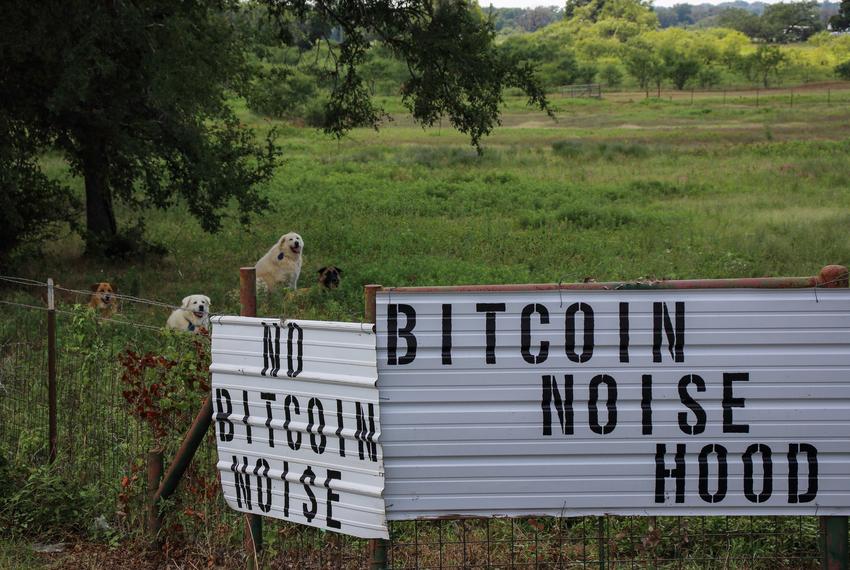

Signs are displayed on the fence of Cheryl Shadden’s property in Granbury.
Credit:
Keaton Peters for Inside Climate News
A wall on the east side of the Bitcoin facility where it borders a small community of mobile homes was built to dampen the sound. But Shadden, who lives northwest of the mine, said the sound reverberates off the wall, and depending on atmospheric conditions, neighbors miles away hear the noise. Even with first steps taken by Marathon, she said the noise is as bad as ever.
Local law enforcement has cited Marathon more than 30 times for violating noise limits above 85 decibels. From the edge of Shadden’s property, her neighbor measured 87.9 on a decibel reader the same day that the Senate hearing took place. Neighbors have talked to local elected officials, but they say there hasn’t been any significant action resulting from those meetings.
“You certainly get the impression that there’s people that see this is just a great, you know, money opportunity for the county, right? And the health issues they haven’t gotten too concerned about,” said Granbury resident John Highsmith.
Neighbors are also taking aim at the power plant, and have complained to Constellation, arguing that it is putting the community at risk by renting to the Bitcoin mine. Separately, they are preparing for a hearing with the state environmental regulator in the fall to challenge the company’s plans to increase air pollution by expanding the power plant. Hood County residents, including one of the county commissioners, have also been pressuring the county not to renew Constellation Energy’s tax abatement.
“This community has had enough,” Shadden said.
Big news: director and screenwriter Richard Linklater; NPR President and CEO Katherine Maher; U.S. Rep. Pete Aguilar, D-California; and Luci Baines Johnson will take the stage at The Texas Tribune Festival, Sept. 5–7 in downtown Austin. Buy tickets today!
Bitcoin
Grayscale Unveils Bitcoin Mini Trust ETF

Bitcoin Currency
Grayscale Investments The Bitcoin Mini Trust began trading on Wednesday with a 0.15% expense ratio, offering a lower-cost option for bitcoin exposure in the market.
The Mini Trust, which has the symbol BTC and trades on NYSE Arca, is structured as a spin-off of the Grayscale Bitcoin Trust (GBTC). New shares will be distributed to existing GBTC shareholders with the fund contributing a portion of its bitcoin holdings to the new product. According to a company press releaseBTC’s S-1 registration statement became effective last week.
“The Grayscale team has believed in the transformative potential of Bitcoin since the initial launch of GBTC in 2013, and we are excited to launch the Grayscale Bitcoin Mini Trust to help further lower the barrier to entry for Bitcoin in an SEC-regulated investment vehicle,” said David LaValle, Senior Managing Director and Head of ETFs at Grayscale.
The Bitcoin Mini Trust’s debut comes amid growing interest in ETFs based on the current price of the two largest cryptocurrencies by market cap, bitcoin and ether. Spot bitcoin ETFs have generated nearly $18 billion in inflows since the first ones began trading on Jan. 11, though GBTC has lost nearly $19 billion in assets.
This fund differs from other funds because it is a conversion of an existing fund and has a 1.5% fee, the highest among spot bitcoin products that have received SEC approval this year.
Mini Bitcoin Trust Low Fee
On a Post X On Wednesday, Bloomberg senior ETF analyst Eric Balchunas noted the Bitcoin Mini Trust’s “lowest fee in the category…”
“[Important] to recognize how incredibly cheap 15bps is — about 10x cheaper than spot ETFs in other countries and other vehicles,” Balchunas wrote, adding that this pricing strategy reflects the competitive nature of the U.S. ETF market, which he referred to as the “ETF Terrordome.”
“This is what Terrordome does to fund [cost]. It reaches 1.5% [and] end in 0.15%, how to go from [a] country club to the jungle. But that’s why all the flows are here, investor paradise,” he noted.
Read more: Spot Bitcoin ETF Inflows Hit Daily High of Over $1 Billion
Bitcoin was recently trading at around $66,350, virtually flat since U.S. markets opened on Wednesday.


Grayscale also offers two spot Ethereum ETFs, the Grayscale Ethereum Trust (ETHE) and the Grayscale Ethereum (ETH) Mini Trustwhose performance is based on ETHE. ETHE outflows exceeded $1.8 billion in its first six days of trading, while ETH added more than $181 million in the same period, according to Farside. The remaining seven ETFs generated about $1.2 billion in inflows.
The story continues
Read more: Spot Ethereum ETFs Approved to Start Trading
Permanent link | © Copyright 2024 etf.com. All rights reserved
Bitcoin
Bitcoin (BTC) Price Drops Below $65K After FOMC as Middle East Tensions Rise
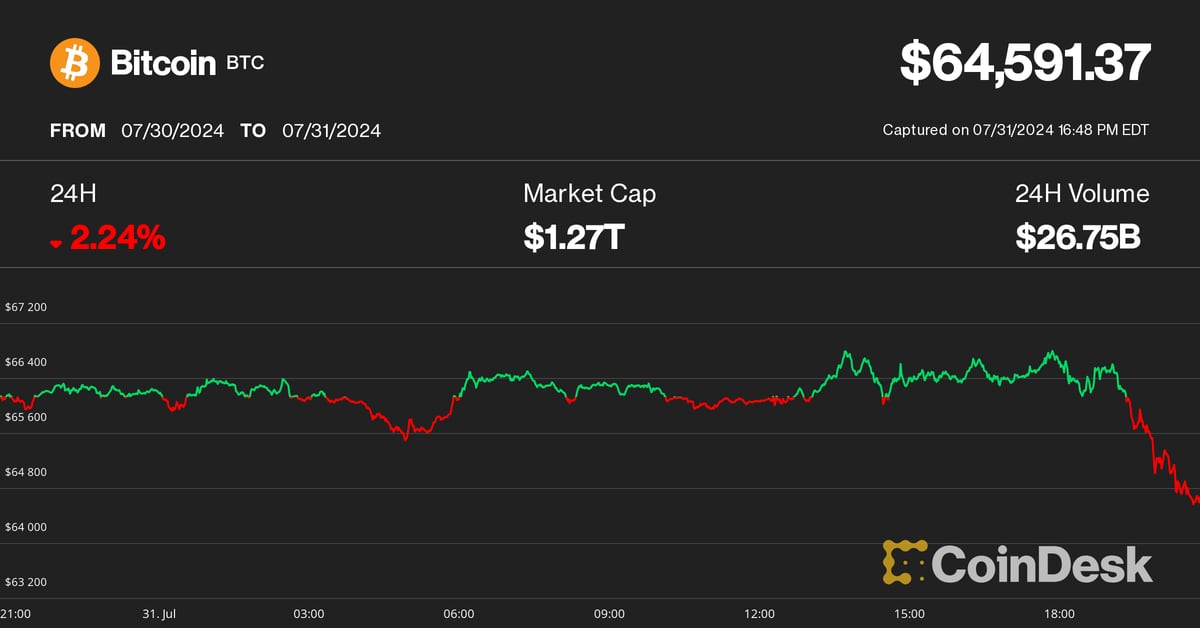
Cryptocurrencies fell sharply on Wednesday as rising geopolitical risks captivated investors’ attention following the conclusion of the Federal Reserve’s July meeting.
Bitcoin (BTC) fell to $64,500 from around $66,500, where it traded following Federal Reserve Chairman Jerome Powell’s press conference and is down more than 2% in the past 24 hours. Major altcoins including ether (ETH)sunbathing (SUN)Avalanche AVAX (AVAX) and Cardano (ADA) also fell, while Ripple’s XRP saved some of its early gains today. The broad cryptocurrency market benchmark CoinDesk 20 Index was 0.8% lower than 24 hours ago.
The liquidation happened when the New York Times reported that Iran’s leaders have ordered retaliation against Israel over the killing of Hamas leader Ismail Haniyeh in Tehran, raising the risk of a wider conflict in the region.
Earlier today, the Fed left benchmark interest rates unchanged and gave little indication that a widely expected rate cut in September is a given. The Fed’s Powell said that while no decision has been made on a September cut, the “broad sense is that we are getting closer” to cutting rates.
While digital assets suffered losses, most traditional asset classes rose higher during the day. U.S. 10-year bond yields fell 10 basis points, while gold rose 1.5% to $2,450, slightly below its record highs, and WTI crude oil prices rose 5%. Stocks also rallied during the day, with the tech-heavy Nasdaq 100 index rebounding 3% and the S&P 500 closing the session 2.2% higher, led by 12% gains in chipmaker giant Nvidia (NVDA).
The different performances across asset classes could be due to traders’ positioning ahead of the Fed meeting, Zach Pandl, head of research at Grayscale, said in an emailed note.
“Equities may have been slightly underutilized after the recent dip, while bitcoin is coming off a strong period with solid inflows, while gold has recovered after a period of weakness,” he said.
“Overall, the combination of Fed rate cuts, bipartisan focus on cryptocurrency policy issues, and the prospect of a second Trump administration that could advocate for a weaker U.S. dollar should be viewed as very positive for bitcoin,” he concluded.
UPDATE (July 31, 2024, 21:30 UTC): Adds grayscale comments.
Bitcoin
Donald Trump’s Cryptocurrency Enthusiasm Is Just Another Scam
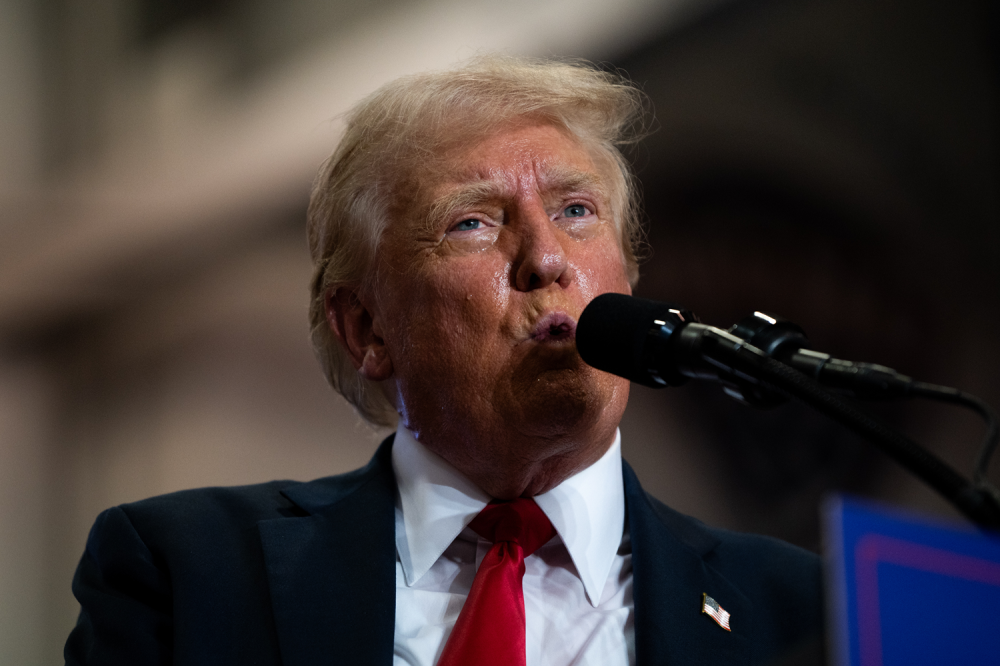
Former US President Donald Trump spoke at the Libertarian National Convention in May and lent his a strong support to crypto: “I will also stop Joe Biden’s crusade to crush crypto. … I will ensure that the future of crypto and the future of bitcoin is made in the US, not taken overseas. I will support the right to self-custody. To the 50 million crypto holders in the country, I say this: With your vote, I will keep Elizabeth Warren and her henchmen out of your bitcoin.”
Former US President Donald Trump spoke at the Libertarian National Convention in May and lent his a strong support to crypto: “I will also stop Joe Biden’s crusade to crush crypto. … I will ensure that the future of crypto and the future of bitcoin is made in the US, not taken overseas. I will support the right to self-custody. To the 50 million crypto holders in the country, I say this: With your vote, I will keep Elizabeth Warren and her henchmen out of your bitcoin.”
Trump continued to court the cryptocurrency industry in the months that followed; he he appeared at the Bitcoin 2024 Conference in Nashville this week, along with independent presidential candidate Robert F. Kennedy Jr.’s parting words to Trump — “Have fun with your bitcoin, your cryptocurrency and whatever else you’re playing with” — were less than enthusiastic, but the industry itself remains packed with ardent Trump supporters.
This turnaround came as a surprise, given Trump’s previous strong opposition to cryptocurrency. When Facebook was floating its Libra cryptocurrency in 2019, Trump tweeted: “I am not a fan of Bitcoin and other cryptocurrencies, which are not money, and whose value is highly volatile and based on thin air.” Former national security adviser John Bolton’s White House memoir, The Room Where It Happened, quotes Trump as telling Treasury Secretary Steven Mnuchin: “Don’t be a trade negotiator. Go after Bitcoin.” [for fraud].” In 2021, Trump counted Fox Business that bitcoin “just looks like a scam. … I want the dollar to be the world’s currency.”
Why the change? There doesn’t seem to be any crypto votes. Trump’s “50 million” number comes from a poorly sampled push survey by cryptocurrency exchange Coinbase which claimed 52 million cryptocurrency users in the United States starting in February 2023. But one survey A survey conducted last October by the US Federal Reserve showed that only 7% of adults (about 18.3 million people) admitted to owning or using cryptocurrencies — down from 10% in 2022 and 12% in 2021. Many of these people are likely wallet owners who were left holding the bag after crypto plunged in 2022 — and are not necessarily new fans.
What Trump wants from the cryptocurrency industry is money. The cryptocurrency industry has already raised more than US$ 180 million to run in the 2024 US elections through his super PACs Fairshake, Defend American Jobs and Protect Progress.
Fairshake spent $10 million on taking Rep. Katie Porter in the primary battle for Dianne Feinstein’s California Senate seat by funding Porter’s pro-crypto rival Adam Schiff. This put $2 million to knock out Rep. Jamaal Bowman in the Democratic primary for New York’s 16th District in favor of pro-crypto George Latimer. In the Utah Senate Republican primary, Rep. John Curtis defeated Trent Staggs with the help of $4.7 million from Defend American Jobs. In Alabama’s House District 2, the majority of campaign expenses came from the cryptocurrency industry.
Fairshake is substantially financed by Coinbase, cryptocurrency issuer Ripple Labs, and Silicon Valley venture capital firm Andreessen Horowitz, or a16z. Silicon Valley was awash in cryptocurrencies during the 2021 bubble, and a16z in particular continues to promote blockchain startups to this day — and still holds a huge amount of bubble crypto tokens that he wishes he could cash in on.
Many in Silicon Valley would like an authoritarian who they think will let them run wild with money — while bailing them out in tough times. Indeed, Trump promised Bitcoin 2024 participants that he hold all bitcoins that the United States acquires. (Never mind that it is usually acquired as the proceeds of crime.) Silicon Valley explicitly sees regulation of any kind as its greatest enemy. Three a16z manifestos — “Politics and the Future” It is “The Techno-Optimist Manifesto” and 2024 “The Small Tech Agenda—describe co-founders Marc Andreessen and Ben Horowitz’s demands for a technology-powered capitalism unhindered by regulation or social considerations. They name “experts,” “bureaucracy,” and “social responsibility” as their “enemies.” Their 2024 statement alleges that banks are unfairly cutting off startups from the banking system; these would be crypto companies funded by a16z.
Trump’s vice presidential pick, Senator J.D. Vance, is a former Silicon Valley venture capitalist. He was once employed by Peter Thiel, who bankrolled Vance’s successful 2022 Senate run; Vance has been described as a “Thiel creation”. He has increased support for the Trump ticket among his venture capital associates. Vance is a bitcoin holder and a frequent advocate of encryption. He recently released a draft bill to review how the Securities and Exchange Commission (SEC) and the Commodity Futures Trading Commission (CFTC) control crypto assets. In 2023, he circulated a bill to prevent banks from cutting out cryptocurrency exchanges.
Minimal regulation has been tried before. It led to the wild exuberance of the 1920s, which ended with the Black Tuesday crash of 1929 and the Great Depression of the 1930s. Regulators like the SEC were put in place during this era to protect investors and transform the securities market from a jungle into a well-tended garden, leading to many prosperous and stable decades that followed.
Crypto provides the opposite of a stable and functional system; it is a practical example of how a lack of regulation allows opportunists and scammers to cause large-scale disasters. The 2022 Crypto Crash repeated the 2008 financial crisis in miniature. FTX’s Sam Bankman-Fried was feted as a financial prodigy who would perform economic miracles if you just gave him carte blanche; he ended up stealing billions of dollars of customers’ money, destroying the lives of ordinary people, and is now in a prison cell.
U.S. regulators have long been concerned about the prospect of cryptocurrency contagion to the broader economy. Criminal money laundering is rampant in cryptocurrency; even the Trump administration has made rules in December 2020 to reduce the risk of money laundering from crypto. Meanwhile, the crypto industry has persistently tried to infiltrate systemically risky corners of the economy, such as pension funds.
Four U.S. banks collapsed during the 2023 banking crisis, the first since 2020. Two of them, Silvergate Bank and Signature Bank, were deeply embedded in the crypto world — Silvergate in particular appears to have collapsed directly from its heavy reliance on FTX and failed a few months after that. Silicon Valley Bank was not involved in crypto but collapsed due to a run on the bench due to panic among venture capital deposit holders, particularly Thiel’s Founders Fund.
Project 2025the Heritage Foundation mammoth conservative wish list The plan, which Trump and Vance have both endorsed and tried to distance themselves from at various times, emphasizes the importance of party loyalists, noting especially financial regulation. The plan recommends replacing as much of the federal bureaucracy as possible with loyalists and “trusted” career officials rather than nonpartisan “experts.” Vance defended in 2021 that Trump should “fire every mid-level bureaucrat, every civil servant in the administrative state” and “replace them with our people.” Loyalty will likely trump competence.
Crypto is barely mentioned directly in Project 2025 — suggesting it has little active support among the broader conservative coalition. But near the end of the manifesto is a plan to dismantle most U.S. financial regulations and investor protections put in place since the 1930s, suggesting the exemption the crypto industry seeks from current SEC and CFTC regulations.
Bitcoin, the first cryptocurrency, started as an ideological project to promote a strange variant of Murray Rothbard’s anarcho-capitalism and the Austrian gold-backed economy—the kind we abandoned to escape the Great Depression. Crypto quickly co-opted the “end of the Fed” and “establishment elites” conspiracy theories of the John Birch Society and Eustace Mullins. It’s a way for billionaire capitalists like Thiel, Andreessen and Elon Musk to claim they’re not part of the so-called elite.
If a second Trump administration were to limp along with financial regulators and allow cryptocurrencies to have free rein, it could help foster the collapse of the U.S. economy that bitcoin claimed to prevent. But Trump is more likely to be happy to take the crypto money and run.
Bitcoin
Trump’s Bitcoin (BTC) Reserve Plan Seen as Just a ‘Small Token Stash’
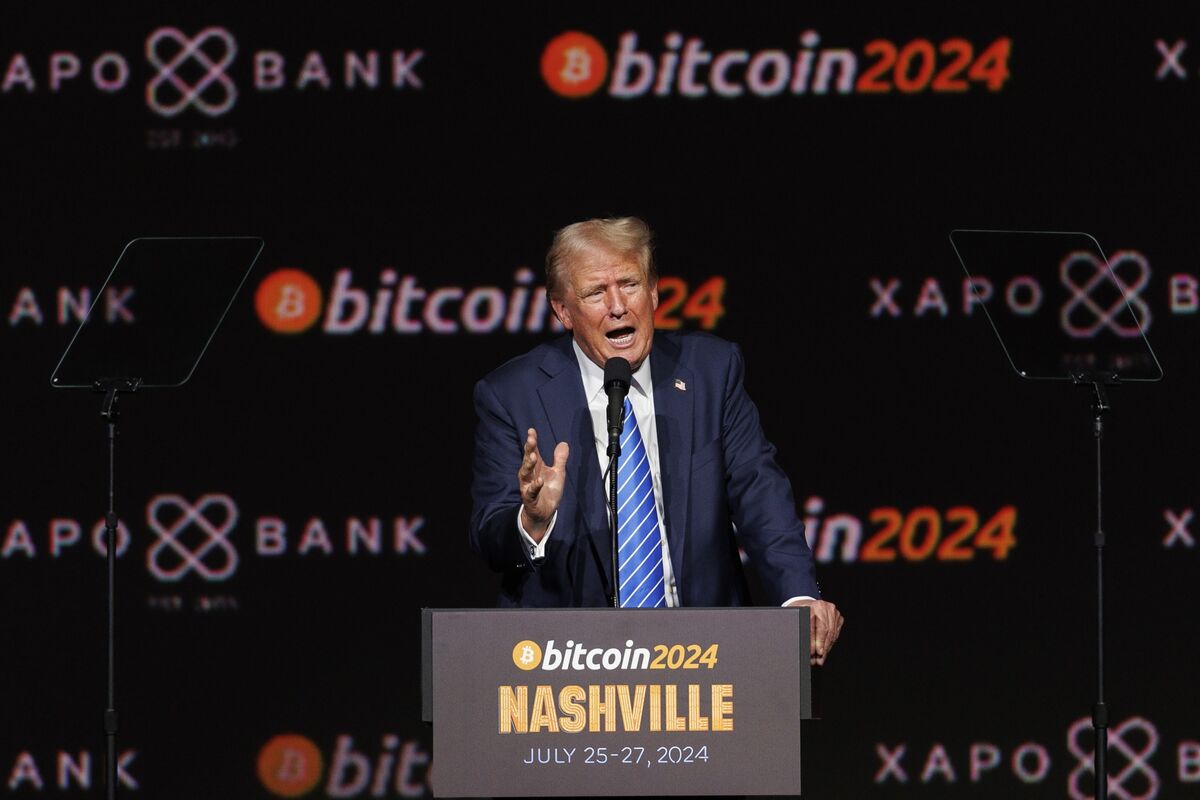
Donald Trump’s recent promise to create a “strategic national stockpile of Bitcoin” may not turn out to be as big a commitment as the hype surrounding the announcement makes it seem.
“Trump’s proposal is extremely modest,” said George Selgin, director emeritus of the Center for Monetary and Financial Alternatives at the Cato Institutea Washington-based public policy group. “It doesn’t have much economic implication.”
-

 Ethereum12 months ago
Ethereum12 months agoEthereum Posts First Consecutive Monthly Losses Since August 2023 on New ETFs
-

 Regulation12 months ago
Regulation12 months agoCryptocurrency Regulation in Slovenia 2024
-

 News12 months ago
News12 months agoNew bill pushes Department of Veterans Affairs to examine how blockchain can improve its work
-

 Regulation12 months ago
Regulation12 months agoThink You Own Your Crypto? New UK Law Would Ensure It – DL News
-

 Regulation12 months ago
Regulation12 months agoUpbit, Coinone, Bithumb Face New Fees Under South Korea’s Cryptocurrency Law
-

 Regulation12 months ago
Regulation12 months agoA Blank Slate for Cryptocurrencies: Kamala Harris’ Regulatory Opportunity
-

 Regulation12 months ago
Regulation12 months agoBahamas Passes Cryptocurrency Bill Designed to Prevent FTX, Terra Disasters
-

 Regulation12 months ago
Regulation12 months agoIndia to Follow G20 Policy for Cryptocurrency Regulation: MoS Finance
-

 News1 year ago
News1 year ago“Captain Tsubasa – RIVALS” launches on Oasys Blockchain
-

 Ethereum1 year ago
Ethereum1 year agoComment deux frères auraient dérobé 25 millions de dollars lors d’un braquage d’Ethereum de 12 secondes • The Register
-

 News12 months ago
News12 months agoEU supports 15 startups to fight online disinformation with blockchain
-

 News1 year ago
News1 year agoSolana ranks the fastest blockchain in the world, surpassing Ethereum, Polygon ⋆ ZyCrypto

















